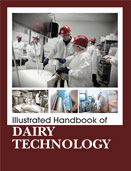Handbooks

Dairy technology is an engineering field that deals with the processing of milk and its products. Dairy technology study involves processing, storage, packaging, distribution and transportation of dairy products by implying the science of bacteriology, nutrition and biochemistry. Apart from that, some principles of physics, engineering, economics and chemistry are also incorporated in the field of dairy technology, in order to develop the appropriate utilization of milk and their products. This guide primarily deals with topics such as- milk production, animal husbandry, cattle rearing, storage of milk, transportation and packing of dairy products, modern technology used in dairy sector, chemistry, nutrition science, marketing, management, dairy unit operations etc.
Dairy is a vital part of the global food system and it plays a key role in the sustainability of rural areas in particular. Milk is as ancient as mankind itself, as it is the substance created to feed the mammalian infant. These included cows, buffaloes, sheep, goats, and camels, all of which are still used in various parts of the world for the production of milk for human consumption. Fermented products such as cheeses were discovered by accident, but their history has also been documented for many centuries, as has the production of concentrated milks, butter, and even ice cream. Technological advances have only come about very recently in the history of milk consumption, and our generations will be the ones credited for having turned milk processing from an art to a science. The availability and distribution of milk and milk products today in the modern world is a blend of the centuries old knowledge of traditional milk products with the application of modern science and technology.
Illustrated Handbook of Dairy Technology provides a uniquely comprehensive and integrated coverage of the principles of physical, chemical, enzymatic, and microbial transformations in dairy products. Dairy technology is a division of engineering that deals with the processing of milk and its products. It is a well-known fact that the dairy industry actively contributes to the economies of a number of communities, regions and countries. An increasing demand worldwide is noticeably emerging at present, and the industry is globalizing, thus increasing the scope and intensity of the global dairy trade. However, the question of how and on what criteria we can objectively assess the economic benefits of the dairy sector still remains. Automation technology is changing the way we produce milk, and the benefits are far-reaching: improved profitability, milk quality, lifestyle and animal welfare. It can also provide us with information about the cow that we have not had before, to support decision-making. To successfully process a complex material such as milk and its by-products with membranes requires an understanding of the interactions between individual components of milk under different processing conditions. Diverse factors impose additional limitations, the most important being that, as a food product, the membrane process must follow certain sanitary guidelines, which imposes further limitations on the selection of the membrane and other materials of contact. Milk and its products are vitally important to the nutrition and health of children and many adults. Its universal importance places it among the most desired of all food products, and milk is also the source of important industrial chemicals. The dairy industry of the world has been highly regarded for many years. Indeed, milk is an extraordinarily complex and nutritious food that includes most of the nutrients known as essential to health and development. This text addresses the current technological factors that are influencing the character of the dairy industry worldwide.
Illustrated Handbook of Dairy Technology provides an up-to-date introduction to the subject. This Handbook is intended to students and researchers involved in the field of Dairy Industry.